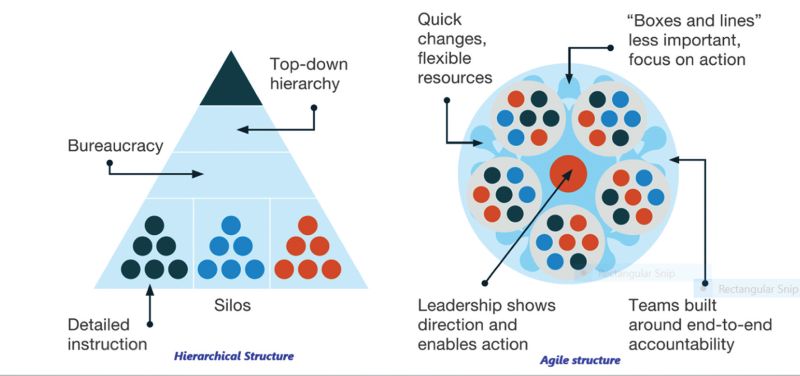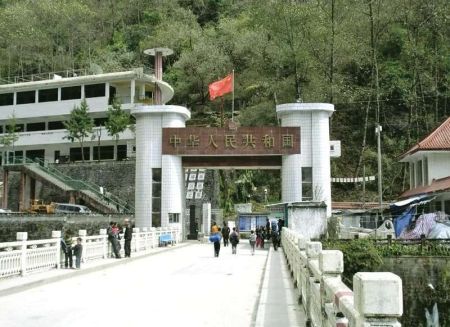Today organisations operate in a constantly evolving business environment and with this level of evolution, the future is uncertain.
--BY SAURAV POUDYAL
When we think of a business structure, even today hierarchy is what comes to our mind in the first place. An organisation is often thought upon as a unit with multiple components such as production line, marketing, distribution, etc. Similar to a machine which is also a unit with multiple moving parts which, when they move in unison, produce the desired output from the machine. But, there is one major differentiator between an organisation and a machine –“Humans”. Yes, “Humans”. Organisations are made up of humans unlike the rigid moving parts in a machine. An organisation is comprised of multiple units that are run by humans. Hence, today, it is essential to think of organisations as living organisms rather than a machine as depicted traditionally.
The absolute features of a traditional hierarchical organisation are defined by rigid, siloed, top-down flow of decisions and goals and concentrated authority among top management. It is focused on capturing value for share holders and output is the only end concern. This was considered the most practical approach for a long time and had been dominating organisational structures till very recently.
Today, Organisations are moving from product centric to human centric approaches. Organisations today have learned that profits are by products of customer satisfaction. Companies, from their traditional approach of making money, are moving towards enhancing client experience knowing that profits are earned in the process.
This is where “Agile” comes in. An agile approach is explicitly human focussed not only at the time of delivery but for the entire customer life cycle. Over its course it is committed to creating value for a wider range of stakeholders such as employees, investors, clients, and even communities. In an agile structure a network of teams within a people centred culture operates in rapid learning and faster decision making backed by technology. The driving force for such structures is the sense of common purpose to create value for all stakeholders. Such structures have the ability to reconfigure strategy, structure, processes and technology at a faster pace as per the evolving priorities
The example of Ford Motor Company is considered in many such discussions. In 1910, Ford was one of the many small automobile manufacturers of the time. A decade later, Ford came out as one of the largest automobile companies and owned 60 percent of automobile market shares worldwide. It introduced the moving assembly line in production. This scientific management in its production line reduced the production time from 12 hours to 90 minutes. Thus, it was able to reduce the per unit cost of its vehicles by more than 60 percent. Not to mention better pay and worker friendly environment for its employees and higher return for its shareholders. Using scientific methods and optimizing labour productivity Ford was able to achieve high levels of efficiency. Ford actually defined agile for its time then.
However, this was a long time back where digitisation was almost non-existent. Today the digital revolution is transforming the way we live. It is transforming industries, societies, and economies. The rigidity of a traditional machine organisation cannot cope with the ever changing and constantly evolving business environment of today. But this paradigm shift cannot happen overnight or over a board room discussion. It is a process of imbibing the culture of human centric approach within the entire organisation. And this process is ever evolving as the priorities of both the organisation and the clients are rapidly changing.Traditionally, organisations succeeded by capturing value from their competitors, suppliers and clients for their “shareholders”. This approach might not work as earlier in today’s market. Thus, a rapid shift is being observed from creating value for shareholders to creating value to and for all “stakeholders”.

Less than 10 percent of companies listed in S&P 500 in 1983 remained in S&P 500 in 2013. This shows that the only constant is change. An oxymoron statement perhaps, but true to its core. Many organisations could not adapt to the ever-changing business environment that has been largely driven by technology and digital evolutions in the recent decades. Constantly evolving digital trends, introduction of disruptive technology at a rapid pace, competition to acquire talents, are dominating today’s business world. Agile comes into play with the concept that organisations are living organisms. An agile approach is driven by five broad characteristics:
Strategy: There is a shared purpose and vision with an open view to capitalise on opportunities with flexible resource allocation.
Structure: Structure comprises of networks of empowered teams. The structures are flat and clear with defined accountable roles and robust governance standards. There is active participation among the ecosystem of the organisation.
Process: The decision-making iteration process is rapid with standardised ways of working. There is transparency in information within the environment encouraging continuous learning.
People: The structure promotes cohesive environment with shared leaderships encouraging entrepreneurial drives.
Technology: An agile structure is up to date with the evolving trend in business in terms of technology and appetite to include disruptive technologies.
An agile structure is all about people as agile is more about mindset than physical structure. In a traditional management approach, it was mandated that people need to be directed and controlled and pointed towards what is to be done. But this approach is fast waning. The new school of thought stresses that people when given responsibilities and authority, become highly engaged and collaborate with each other to come out with solutions and efficient ways of working thereby delivering better results. Even in agile structures, there is a stable top-level structure, but below this structure there is a flexible and scalable network of teams. The leadership shows direction and enables action rather than directing ways of doing the job. The teams are fully empowered and are accordingly assigned the accountability.
Thus, an agile structure comprises of cross functional teams which are self-managing depending upon the nature of the task at hand.
Another major feature of the agile environment is the mindset shift in terms of decision making. Traditionally, in any organisation the senior or the most experienced employee defined the road map for the organisation and the employees in the lower tier would follow the instructions to reach there accordingly. However, today organisations operate in a constantly evolving business environment and with this level of evolution, the future is uncertain. Hence, the best strategy to minimise the risk that the future may hold is to be the quickest in adapting to the change and being productive in trying out new approaches to mitigate the risks.
The major catalyst in this paradigm shift in organisational structures has been the rapid evolution of technology. As depicted above many companies listed in S&P 500 in 1983 could not make it through till 2013 as they could not adapt to the technological advancements in the business world. Technology was being viewed as a supporting capability meant for specific tasks only. But, today technology has become an integral tool that is integrated into every aspect of business to drive its efficiency. In an agile structure technology plays the most important role and can solely define the efficiency of the organisation in its entirety.
The challenge that organisations today face is to build an agile workforce. Many organisations might have a false belief that their workforce will keep pace with the digital advancements instead of designing their workforce to keep pace with this changing environment. Technology plays a vital role, but it no longer is the sole competitive differentiator. Thus, the key to workforce agility is to keep people first enabled by technology. In today’s competition, to survive, companies need to invest in predictive intelligence which will help in precise decision making. The biggest threat that companies face today is “tomorrow”. Thus, companies need to be future ready to stand out.
An agile workforce is built on insights and not on any predefined way of working. This workforce has the capability to form and reform continuously. Organisations must continuously think of ways to reskill their employees to be future ready. This results in higher collaboration between the cognitive strengths of humans and technology. By re-designing an organisation’s structure to be more focussed on teams and networks, it can bring about positive changes within the organisation. An agile approach will help in imbibing more human centric methods in the workplace that will have a positive impact for all stake holders be it employees, shareholders, clients or communities.
The author is the Head of Wealth Management at Standard Chartered Bank Nepal Limited. The views presented in the article are of the writer himself and do not represent the organisation that he is associated with.






















